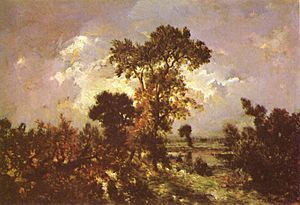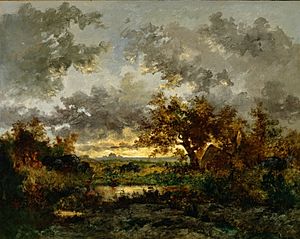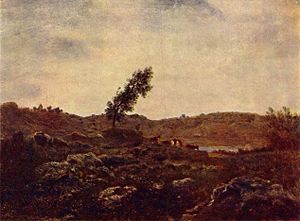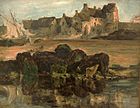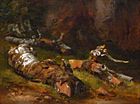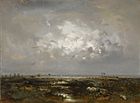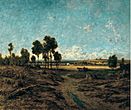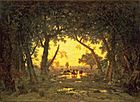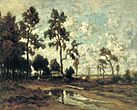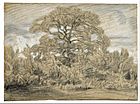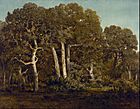Théodore Rousseau facts for kids
Quick facts for kids
Théodore Rousseau
|
|
|---|---|
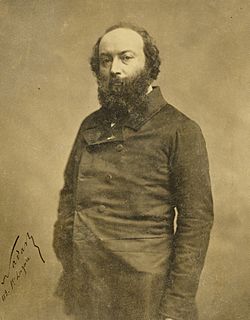 |
|
| Born | April 15, 1812 Paris, France
|
| Died | December 22, 1867 (aged 55) Barbizon, France
|
| Nationality | French |
| Patron(s) | Jean-Charles-Joseph Rémond |
Théodore Rousseau (born April 15, 1812 – died December 22, 1867) was a famous French painter. He was a very important artist in a group called the Barbizon school. These artists loved to paint nature and landscapes, often outdoors.
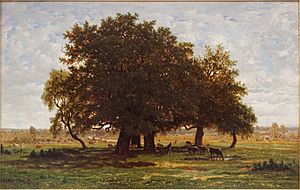
Contents
Life of Théodore Rousseau
Early Life and Art Training
Théodore Rousseau was born in Paris, France. His family was well-off. From a young age, he showed a great talent for painting.
Even though his father first wanted him to go into business, he soon supported Théodore's choice to become an artist. His father was always there for him, especially when Théodore faced problems with the official art shows in Paris.
Challenges with the Paris Salon
In the 1830s, it was hard for artists like Rousseau to get their paintings shown. The art world was controlled by older, more traditional artists. Rousseau's paintings were often rejected by the Paris Salon, which was the main art exhibition in France.
He showed six paintings between 1831 and 1835. But in 1836, his big painting Paysage du Jura was turned down. He sent eight more works over the next few years, but none were accepted. Because of this, he stopped sending his art to the Salon until 1849.
People in the press, like his friend and art critic Théophile Thoré, supported him. They even called him "le grand refusé" (the great rejected one).
During these years when his art was often rejected, Rousseau created some of his best works. These include The Chestnut Avenue, The Marsh in the Landes, and Hoar-Frost. In 1851, after some changes to the Salon, his masterpiece The Edge of the Forest was finally shown.
Moving to Barbizon
Rousseau had only visited Barbizon now and then before. But in 1848, he moved to this small village near the Forest of Fontainebleau. He spent most of the rest of his life there.
He started to earn good money for his paintings, though it was still much less than they would be worth later. More and more people admired his art. Even though his student, Narcisse Virgilio Diaz, received an award first, Rousseau was soon honored with the Cross of the Legion of Honour. He later became an Officer of the Legion of Honor.
At the Exposition Universelle in 1853, all of Rousseau's rejected paintings from the past twenty years were shown together. His works were seen as some of the best art there. However, after a difficult art sale in 1861, he thought about leaving Paris for other cities like Amsterdam, London, or even New York.

Later Years and Health
Rousseau faced some tough times later in his life. He also became ill. In 1863, he visited the Alps and made sketches of Mont Blanc. While there, he became very sick with a lung infection. When he returned to Barbizon, he had trouble sleeping and grew weaker.
He was chosen to be the president of the art jury for the 1867 Exposition. However, his health worsened in August when he became paralyzed. He got a little better but suffered more attacks. In November, his condition became very serious. He passed away on December 22, 1867. His close friend, the painter Jean-François Millet, was with him when he died. Millet took care of Rousseau's wife after his death.
Rousseau's friend and neighbor, Jules Dupré, who was also a landscape painter, said that Rousseau sometimes had trouble knowing when a painting was finished. Dupré would sometimes take a canvas away from Rousseau's studio because he worked on it for too long. Rousseau was also a good friend to Diaz, teaching him how to paint trees.
Théodore Rousseau's Art Style
Rousseau's paintings often have a serious and thoughtful feeling. They show a beautiful sadness. When he finished a painting, it was very detailed. However, Rousseau spent so much time on his art that he didn't complete many paintings.
He left many canvases where some parts were very detailed, but others were less clear. He also made many sketches and watercolor drawings. His drawings in black and white on paper are rare. You can see some of his good paintings in the Louvre Museum in Paris. The Wallace Collection in London also has one of his important Barbizon paintings.
Selected Paintings
-
Thunderstorm over Mont Blanc, 1834; oil-painting
-
A Swamp in Les Landes, 1844, oil on panel, Walters Art Museum
-
A Meadow Bordered by Trees, c. 1845; oil on panel, Metropolitan Museum of Art
-
Thunderstorms mood in the level of Montmartre, 1845-1848, color on panel, Musée d'Orsay
-
The Forest of Fontainebleau: Morning, c 1850, oil on canvas, Wallace Collection, London
-
Study of an Oak Tree, c. 1857-1867, drawing in black and white chalk on paper, Museum of Fine Arts, Houston
-
The Great Oaks of Old Bas-Bréau, 1864, oil on canvas, Museum of Fine Arts, Houston
See also
 In Spanish: Théodore Rousseau para niños
In Spanish: Théodore Rousseau para niños


